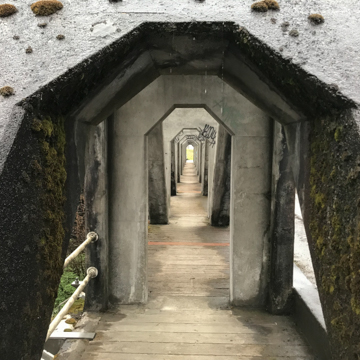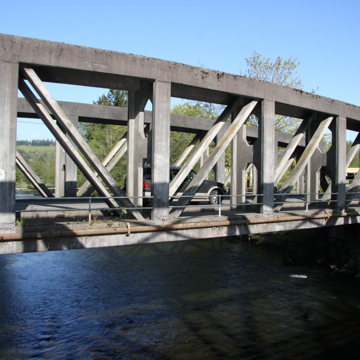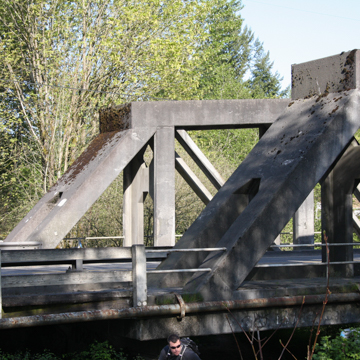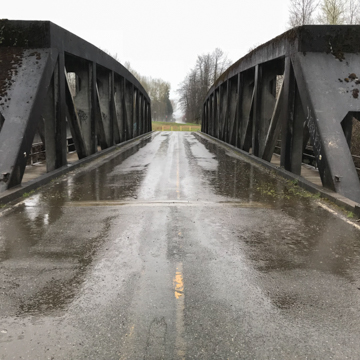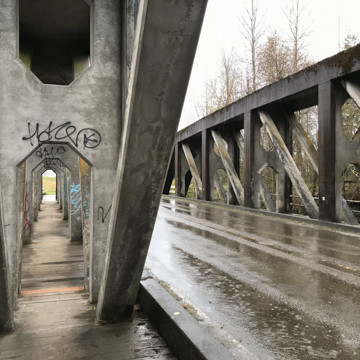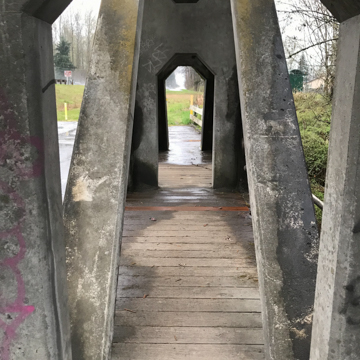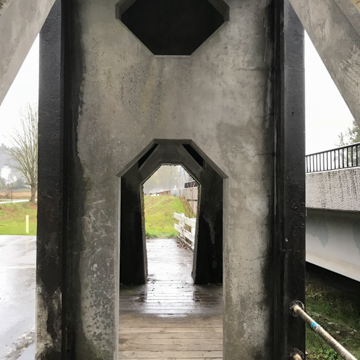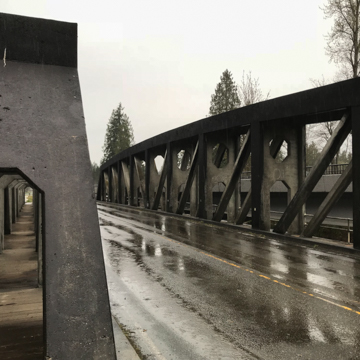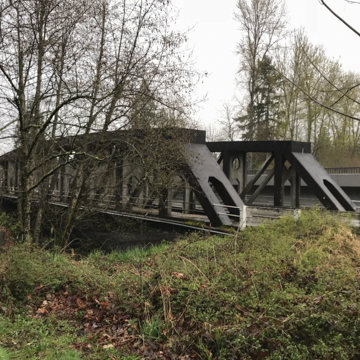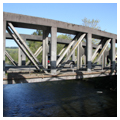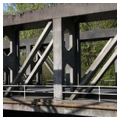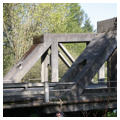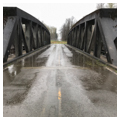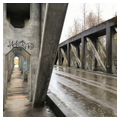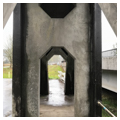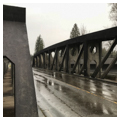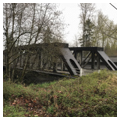You are here
McMillin Bridge
The McMillin Bridge, also known as the Puyallup River Bridge, is a rare example of a reinforced concrete half-truss bridge. At the time of its construction in 1934, the 170-foot-long highway bridge featured the longest reinforced concrete truss span in the United States. The double trusses on each side of the roadway provide covered walkways for pedestrians; their arched-shaped and octagonal openings are character-defining features of the bridge while also helping to reduce the overall dead load of the concrete.
The McMillin Bridge spans the Puyallup River as part of State Route 162, which connects with State Route 410 in Sumner and State Route 165 near Buckley, both historically agrarian communities in Pierce County that face development pressure as part of the growing Seattle-Tacoma metropolitan area. The bridge replaced a 21-year-old, 150-foot steel span whose abutment was undermined during the winter of 1933–1934. Projected cheaper costs and maintenance advantages during the Great Depression led to the selection of a concrete truss instead of a steel span for the replacement bridge, which was $826 less than the lowest bid for a steel highway bridge.
The novel bridge design, developed by Homer M. Hadley, one of Washington’s most innovative twentieth-century engineers, creatively minimized dead loads and reduced concrete. Hadley managed this largely by designing each pier shaft with two, 3-foot-diameter interior circular tubes, thereby creating “hollow box” shafts and reducing material and weight. The end of each truss is supported by rectangular concrete shafts with truncated corners. A concrete wall, 18 inches thick with embedded reinforcing steel, connects the shafts together at each end of the bridge. Openings in the deck between the 7-foot-wide double trusses on either side of the roadway, with their cambered upper chords, further reduce load while adding a distinctive touch. Hadley’s design was produced for the Seattle firm of W.H. Witt, who prepared the construction documents for the general contractor, Dolph Jones of Tacoma.
At the time, Hadley was a regional structural engineer for the Portland Cement Association, and thus understood—and promoted—the advantages of concrete for bridge construction purposes. Perhaps because of the relative newness of the material for bridge design and its heavier dead load, concrete was not in common use nationwide. Yet in the Pacific Northwest, a thriving Portland cement industry in the early twentieth century ensured the ready availability of concrete, and was increasingly a material of choice for the state highway department.
A native of Toledo, Ohio, Hadley enrolled at the University of Washington in 1908 but left before graduating to take railroad surveying jobs in Alaska and Canada. During World War I, Hadley worked for the Emergency Fleet Corporation in Philadelphia as a designer of concrete ships and barges that would later inspire his concrete pontoon-bridge designs. In 1921, Hadley took a job with the Portland Cement Association as a structural engineer. For the next 26 years he promoted the use of concrete, primarily for bridge construction.
Hadley’s work on the McMillin Bridge spearheaded designs for several other concrete bridges in later years. He is credited with inspiring the design for the first concrete box girder bridge built in the United States: the Mashel River Bridge near Eatonville, Washington (1936). Hadley is also considered responsible for the design of the Purdy Bridge near Gig Harbor, Washington, which, at the time, was the longest continuous box-girder bridge in the country. Under a later partnership with his son, Richard, Hadley designed a prototype cable-stayed bridge using box steel girders filled with vermiculite concrete for the Benton City-Kiona Bridge over the Yakima River in Washington. Hadley is also responsible for suggesting the design for the first floating concrete pontoon bridge in the world, built in 1940 on Lake Washington in Seattle (now known as the Lacey V. Murrow Memorial Bridge).
The McMillin Bridge, however, may represent Hadley’s most remarkable achievement in concrete bridge design, and—though the specifics of its unusual design were not widely adopted—it inspired confidence in the use of reinforced concrete by bridge designers in successive years. It is listed on the National Register of Historic Places, the Washington State Heritage Register, and the Pierce County Historic Register. The Washington State Department of Transportation decommissioned the bridge in 2014, with the completion of a wider span over the Puyallup. After a prolonged battle with preservationists, the bridge was left intact. There has been some interest in connecting it into the Foothills Trail, but currently it sits isolated between the new replacement bridge and the Foothills railroad bridge. It is open to pedestrians.
References
Berry, W. E., and George Runciman. “Long Concrete Trusses in Bridge Near Tacoma.” Engineering News-Record (January 2, 1936): 1-4.
Clarke, Jonathan. “Material Concerns in the Pacific Northwest: Steel versus Reinforced Concrete in Highway Bridge Design in Washington State, 1910-1930.” Construction History 16 (2000): 33-60.
Holstine, Craig, and Richard Hobbs. Spanning Washington: Historic Highway Bridges of the Evergreen State. Pullman: Washington State University Press, 2015.
“McMillin Bridge,” Pierce County, Washington. Pierce County Register of Historic Places-Nomination Form, 2013. Landmarks and Historic Preservation Commission, Tacoma, Washington.
Soderberg, Lisa. “McMillin Bridge,” Pierce County, Washington. Historic American Engineering Record, 1979. Prints and Photographs Division, Library of Congress (HAER WASH,27-MCMIL,1-).
Writing Credits
If SAH Archipedia has been useful to you, please consider supporting it.
SAH Archipedia tells the story of the United States through its buildings, landscapes, and cities. This freely available resource empowers the public with authoritative knowledge that deepens their understanding and appreciation of the built environment. But the Society of Architectural Historians, which created SAH Archipedia with University of Virginia Press, needs your support to maintain the high-caliber research, writing, photography, cartography, editing, design, and programming that make SAH Archipedia a trusted online resource available to all who value the history of place, heritage tourism, and learning.

